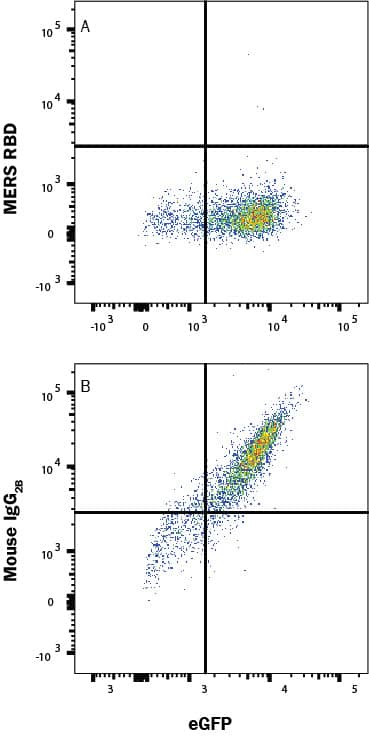MERS-CoV Spike RBD MAb (Cl 1038342)
R&D Systems, part of Bio-Techne | Catalog # MAB107071

Key Product Details
Species Reactivity
MERS-CoV
Applications
Blockade of Receptor-ligand Interaction, Immunocytochemistry
Label
Unconjugated
Antibody Source
Monoclonal Mouse IgG2B Clone # 1038342
Product Specifications
Immunogen
Chinese Hamster Ovary cell line CHO-derived MERS-CoV Spike RBD
Glu367-Tyr606
Accession # YP_007188579.1
Glu367-Tyr606
Accession # YP_007188579.1
Specificity
Detects MERS-CoV Spike RBD in direct ELISAs.
Clonality
Monoclonal
Host
Mouse
Isotype
IgG2B
Scientific Data Images for MERS-CoV Spike RBD MAb (Cl 1038342)
MERS-Cov Spike S1 protein binding to CD26-transfected Human Cell Line is Blocked by MERS-Cov Spike RBD Antibody
In a functional flow cytometry test, Recombinant MERS-Cov Spike S1 Fc-tagged protein (10606-CV) binds to HEK293 human embryonic kidney cell line transfected with recombinant human CD26 and eGFP. (A) Binding is blocked by 50 µg/mL of Mouse Anti-MERS-Cov Spike RBD Monoclonal Antibody (Catalog # MAB107071) but not by (B) Mouse IgG2B Isotype Control (MAB0041). Protein binding was detected with Mouse Anti-Fc APC-conjugated Monoclonal Antibody (FAB110A). Staining was performed using our Staining Membrane-Associated Proteins protocol.Spike RBD in MERS RBD transfected cells.
Spike RBD was detected in immersion fixed MERS RBD transfected cells using Mouse Anti-MERS-CoV Spike RBD Monoclonal Antibody (Catalog # MAB107071) at 8 µg/mL for 3 hours at room temperature. Cells were stained using the NorthernLights™ 557-conjugated Anti-Mouse IgG Secondary Antibody (red; NL007) and counterstained with DAPI (blue). Specific staining was localized to cytoplasm. Staining was performed using our protocol for Fluorescent ICC Staining of Non-adherent Cells.Applications for MERS-CoV Spike RBD MAb (Cl 1038342)
Application
Recommended Usage
Blockade of Receptor-ligand Interaction
In a functional flow cytometry test, 50 μg/mL of Mouse Anti-MERS-Cov Spike RBD Antibody(Catalog # MAB107071) will block the binding of Recombinant MERS-Cov Spike S1 Fc-tagged protein (Catalog # 10606-CV) to HEK293 human embryonic kidney cell line transfected with recombinant human CD26.
Immunocytochemistry
8-25 µg/mL
Sample: Immersion fixed MERS RBD transfected cells
Sample: Immersion fixed MERS RBD transfected cells
Formulation, Preparation, and Storage
Purification
Protein A or G purified from hybridoma culture supernatant
Reconstitution
Reconstitute at 0.5 mg/mL in sterile PBS. For liquid material, refer to CoA for concentration.
Formulation
Lyophilized from a 0.2 μm filtered solution in PBS with Trehalose. *Small pack size (SP) is supplied either lyophilized or as a 0.2 µm filtered solution in PBS.
Shipping
Lyophilized product is shipped at ambient temperature. Liquid small pack size (-SP) is shipped with polar packs. Upon receipt, store immediately at the temperature recommended below.
Stability & Storage
Use a manual defrost freezer and avoid repeated freeze-thaw cycles.
- 12 months from date of receipt, -20 to -70 °C as supplied.
- 1 month, 2 to 8 °C under sterile conditions after reconstitution.
- 6 months, -20 to -70 °C under sterile conditions after reconstitution.
Background: Spike RBD
References
- Zaki, A.M. et al. (2012) N. Engl. J. Med. 367:1814.
- Ogimi, C. et al. (2020) J Pediatric Infect Dis Soc doi: 10.1093/jpids/piaa037.
- Li, Y. et al. (2019) Engineering. 5:940.
- Raj, V.S. et al. (2013) Nature 495:251.
- Corti, D. et al. (2016) J. Infect. Public Health 9:231.
- Tang, X.C. et al. (2014) Proc. Natl. Acad. Sci. USA 111:E2018.
- Jiang, L. et al. (2014) Sci. Transl. Med. 6:234ra59.
Long Name
Spike Receptor Binding Domain
Gene Symbol
S
UniProt
Additional Spike RBD Products
Product Documents for MERS-CoV Spike RBD MAb (Cl 1038342)
Product Specific Notices for MERS-CoV Spike RBD MAb (Cl 1038342)
For research use only
